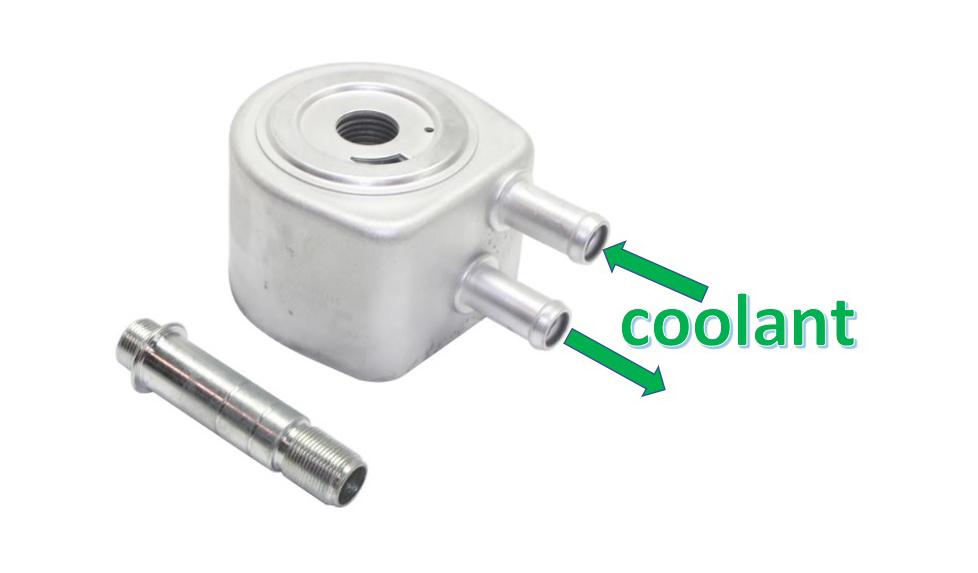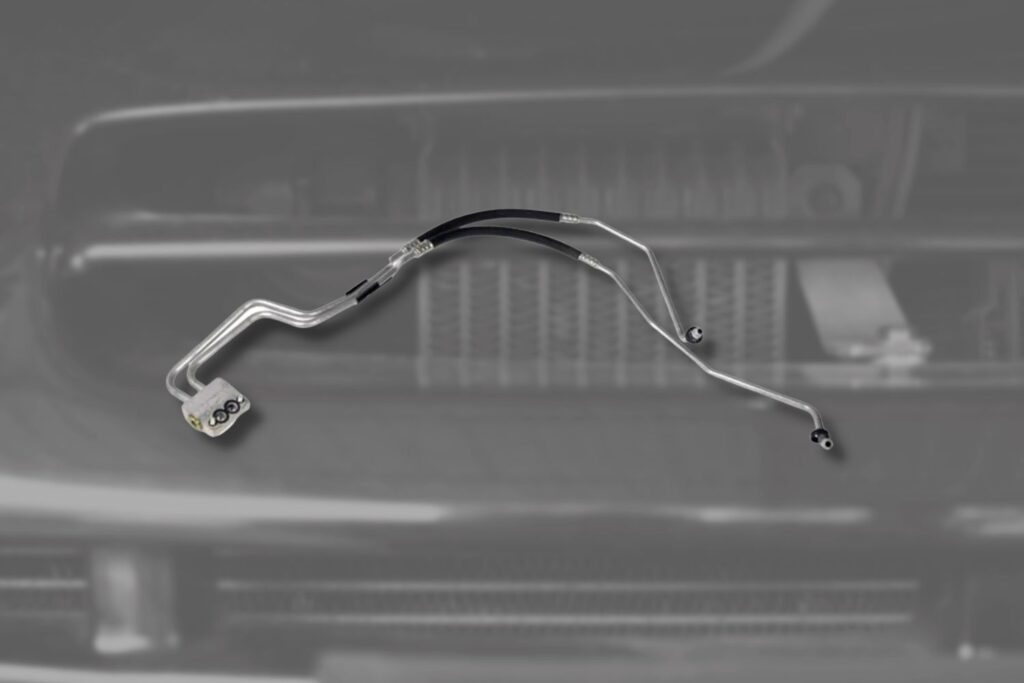What Is the Oil Cooler Line?
The oil cooler line is a hose that connects the engine and the oil cooler. It enables lubricating oil to cycle between these two parts. If something happens to the oil cooler line, it will disrupt the engine cooling process. Unfortunately, the line can develop issues like leaks and crimping that affect oil flow. To protect your vehicle’s engine from serious damage, replace a faulty oil cooler line as soon as your budget and schedule allow.


Symptoms of a Bad Oil Cooler Line
Like any other car part, oil cooler lines undergo wear and tear from use until they reach their limit and fail. Fortunately, there are warning signs that you can watch out for to determine if it’s time to replace an old line.
Low Engine Oil Level
You might have a faulty oil cooler line if the engine oil level drops faster or suddenly loses a considerable amount of oil.
When the oil cooler line wears out, its damaged part might leak oil. The leak will deplete the vehicle’s engine oil. It will also reduce the pressure that moves the lubricant through the oil cooling system.
Most vehicles keep track of their engine oil pressure. When the pressure suddenly drops, the oil light on the dashboard will activate to warn the driver.
You can also manually check the engine oil level by pulling out the dipstick and examining the oil mark on it. If the stick shows that the oil level has gone down, check the oil cooler liner and other parts that use engine oil for leaks.
Engine Oil Puddle Beneath Your Vehicle
Is engine oil pooling on the ground beneath your vehicle’s engine? The oil cooler line might have sprung a leak, allowing lubricant to seep out of its damaged section. The larger the leak, the more oil escapes from the faulty part, leading to the puddle spreading faster over a larger area.
There are several ways for an oil cooler line to spring a leak. Its rubber hose segment deteriorates over time when exposed to intense heat, such as the temperatures generated by a running engine. The worn-out metal ends can also come loose from their connection point.
Many other engine parts use engine oil to lubricate their moving parts and keep cool. Check them to confirm if the problem is an oil cooler line leak or something else.
Damaged Metal Lines
Sometimes, the engine will run hotter than it should, as if it wasn’t getting enough engine oil. The problem might lie with the oil cooler line getting bent or crimped out of shape.
Oil cooler lines have metal lines covering both ends of their central rubber hose segment. One end screws into the oil cooler while the other goes into the engine. Both lines fit snugly within their respective inserts to ensure a tight seal and prevent engine oil from leaking.

Although designed for durability, these metal lines can wear out from exposure to engine vibrations and driving over uneven road surfaces. Depending on the situation, they can also get bent out of shape.
Bent and crimped oil cooler lines will restrict the amount of lubricant and the speed at which the oil passes through them. Hot oil will stay in the engine longer while not enough cooled lubricant will return, leading to higher temperatures.
Some vehicles have easily accessible oil cooler lines. You can visually inspect the lines’ metal ends to see if one or both became bent or crimped. Otherwise, you might need to partially disassemble the engine before you can examine the oil cooler line for signs of bending or crimping.
More About the Oil Cooler Line
Usually, supercharged and turbocharged engines will have an oil cooling system to support their radiator-based engine cooling system. These powerful engines produce more heat than their standard counterparts, which requires more capable cooling.
You can usually find the oil cooler line near the engine’s front. That location puts it closer to the oil cooler.
A typical oil cooler line consists of a rubber hose in the middle with metal tubes on both ends. One metal line fits into the engine, while the other goes into the oil cooler. Meanwhile, the flexible hose can bend around corners and expand its width to handle an influx of more engine oil.
What Does the Oil Cooler Line Do?
The oil cooler line plays an integral role in the oil cooling system. Like the engine cooling system, the oil-based system removes excess heat from the engine. The two systems work together to ensure that the engine runs within a safe range of operating temperatures.
Engine oil passes through the oil cooler line to reach the cooling device. As the oil flows through the cooler, it can release the heat absorbed during its passage through the running engine. The now-cooled engine oil can return to the engine.
When Should You Replace the Oil Cooler Line?

The oil cooler line will need to be replaced at least once before the 100,000-mile mark. Refer to your owner’s manual for the recommended time to get a new line. In most cases, hire a professional technician to replace the old oil cooler lines because the arduous task requires special tools.
You can make the oil cooler line last longer by following the manufacturer’s recommended maintenance schedule. Change the engine oil and oil filter regularly. Keeping the oil clean reduces the chances of a clogged line.
How Much Does an Oil Cooler Line Replacement Cost?
You can expect to pay anywhere between $10 and $560 for a new oil cooler line. The replacement part’s price tag can vary according to a number of factors, such as your vehicle’s make and model and the oil cooler line’s manufacturer.
Where to Get a New Oil Cooler Line for Your Vehicle
It’s not a good idea to drive with a damaged oil cooler line, as it could lead to overheating and other temperature-related issues. These problems can make driving a hassle and result in expensive repairs. Luckily, CarParts.com makes finding replacement auto parts and accessories a breeze.
With only a few clicks, you can find the right part for your ride on our website. Find the oil cooler lines that are compatible with your ride by filling out our vehicle selector. Then, find the ones that match your preferred brand, price, and other features using the filters. Check out securely in minutes.
All our parts are on hand and ready to ship from a warehouse near you. Place your order today, and get it in as fast as two business days. And in the unlikely event that you’re unsatisfied with your order, we have a 60-day return policy. Simply file a claim through our returns center, and we’ll issue you a full refund.
Shop for a new oil cooler line and repair your ride in no time.
Any information provided on this Website is for informational purposes only and is not intended to replace consultation with a professional mechanic. The accuracy and timeliness of the information may change from the time of publication.



























